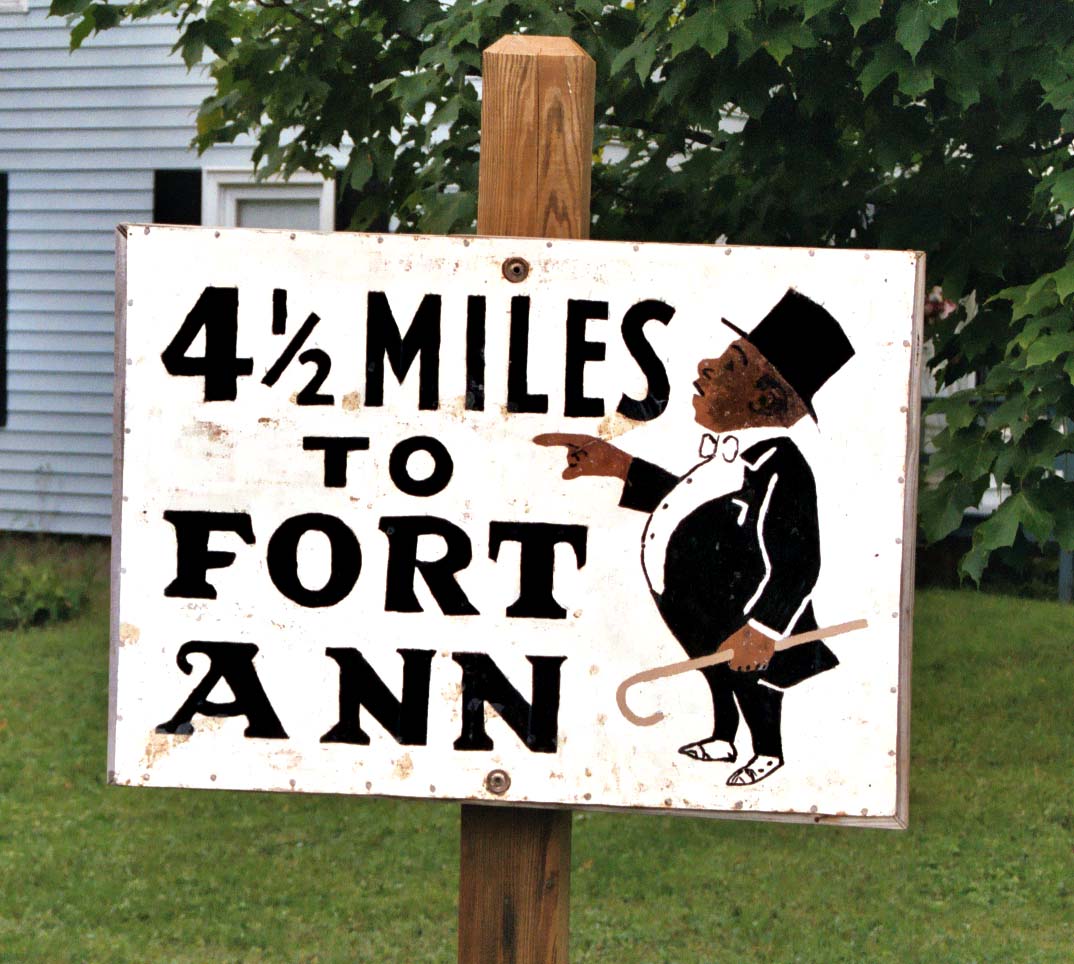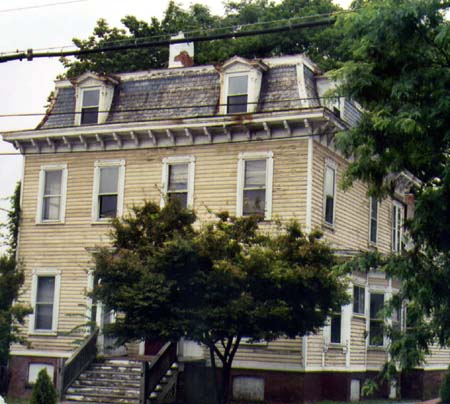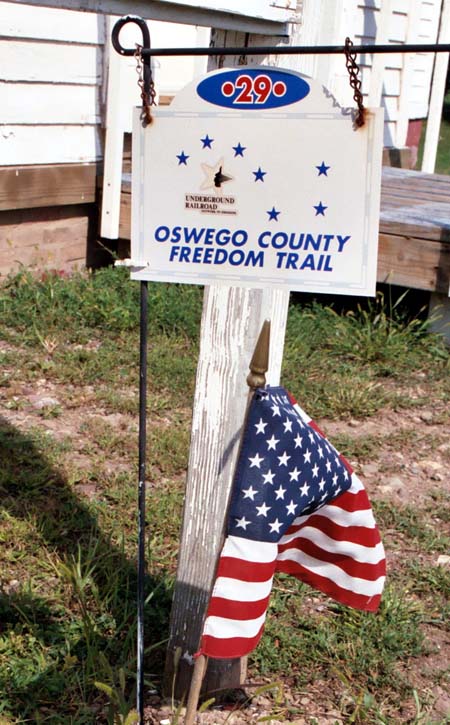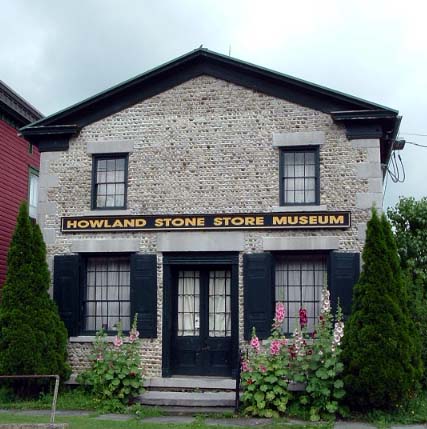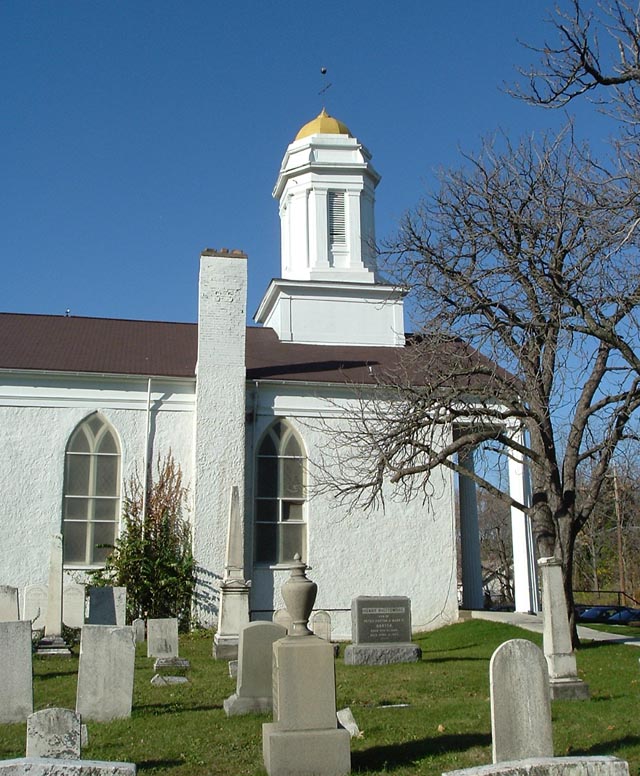|
|
|
|
Well-documented
stations of the Underground Railroad
The Thomas Root Home in Pekin (Upper Mountain Road in Niagara County) is pictured at the top left
of this page. It is one of several sites on the Underground Railroad that
has sufficient documentation to support its role in the illegal system
of "slave-stealing." Perhaps Freedom Seekers (fugitives) spent only
a few hours here. They might have rested here for days. But they didn't have
far to go for freedom. The crossings on the Niagara River are only a few
miles to the west. Then they would be in Canaan, the Promised Land
of Canada.
As explained on the previous page, New's
York's long border with Canada made it an important way station on the
Underground Railroad. Usually fugitives came to New York City via
Philadelphia. Then they found their way (with assistance, usually) up to
the Hudson River. From there they often went west along the Erie Canal towards the ports on Lake Ontario or the Niagara Country. Or
they might have moved up the Champlain Valley into Quebec or across
the St. Lawrence River into Canada West (Ontario Province). There is
also good evidence that many Freedom Seekers came up the Susquehanna Valley
from Central Pennsylvania. That means that the Souther Tier and the Finger
Lakes Region had important stations, too. Sometimes, when it was too dangerous
to cross into Canada at Detroit, the runaways were sent along Lake Erie's
shore into Western New York. This kept agents like Eber Pettit of Fredonia/
Versailles very busy.
It is often difficult separating history from mythology when it
comes the Underground Railroad. It sometimes seems that every house
dating from the 19th century had some kind a hidden passageway, or a fake
attic to protect Freedom Seekers from capture. Of course, there probably
were no more a handful of "safe houses" in most towns, maybe less. And, since
they faced serious fines and jail time for assisting fugitives, most stationmasters
never kept records. What we know about these places often comes from interviews
with family members or neighbors who were young children at the time.
Here are some of the most most well-documented sites on the Underground
Railroad in New York State:
1. David Ruggle's Home (TriBeCa
- Manhattan): David Ruggle is perhaps one of the most forgotton black warriors
against slavery. He helped perhaps one thousand Freedom Seekers escape
to more safe communities in Upstate New York and Canada during the 1830s.
The most famous fugitive to seek shelter in his home on Lispernard Street
(long demolished) was Fred Bailey, known to us all as Frederick Douglass.
2. Lafayette Street Baptist Church (Brooklyn): This African-American Church on Oxford Street was a known safe
house for fugitives even when slavery was still legal in New York. From
there, Freedom Seekers were often sent to other black or Quaker communities
in the Hudson Valley.
3. Samuel Keese Smith House (Peru
- Clinton County): There has recently been a resurgence of interest in
the Underground Railroad in the North Country, thanks partly to the work
of Tom
Calarco. Also, Addie Shields, Historian of Clinton County, has provided
us with incredible information about stations, black and white near the shores
of Lake Champlain. One definite site was the home of Samuel Keese Smith a
few miles south of Plattsburgh.
4. Old Stone Library (Fort Ann
- Washington County): Tom Calarco has also written about the secret railroad
in Washington County. Runaways were most certainly sheltered in Fort Ann
in what is now the Old Stone Library. Nearby in Vaughn Corners is a cryptic
sign that not only directs people to Fort Ann, but seems to give directions
to a port on Lake Champlain. Very curious.
5. Stephen and Harriet Myers Home
(Albany): Thanks to tireless research by the husband-wife team of Mary Liz
and Paul Stewart, this very important station in the Capital District has
been rediscovered and recognized as part of the Freedom Trail. The Myers
(African-Americans) not only helped Freedom Seekers on their journeys, but
they were leaders in the Albany Vigilance Committee.
6. John Sands House (Peekskill
- Westchester County): Peekskill has a very fascinating history in regards
to the Underground Railroad. Near McGregory Brook that flows through town
to the Hudson is the A.M.E. Zion Church and John
Sands Home on Main Street. There is also a tunnel nearby that might have
concealed fugitives until they could be moved elsewhere. This seems to indicate
that there was a close alliance between the black and white communities
not only in Peekskill, but also throughout the state.
7. Catherine Harris Home (Jamestown):
This gentle black lady quietly assisted hundreds of Freedom Seekers who
came to Chautauqua County from Pennsylvania or Ohio. A small black community
called "Africa" existed on 7th Street. Such communities like this are being
"rediscovered" as new research on the Underground Railroad is being carried
out.
8. John W. Jones House (Elmira):
We are greatly pleased to read that the long abandoned home of John W. Jones,
one of the most creative agents on the "railroad" is being restored into
a museum in Elmira. He did this dangerous work knowing full well the consequences
that the Fugitive Slave Law could rain down on him as a black man. In Elmira,
the real railroad was used extensively, as Freedom Seekers were hidden
in baggage cars and sent on to Niagara.
9. Bristol Congregational Church (Volney - Oswego County): Under the leadership of Prof. Judith Wellman
of SUNY Oswego extensive scholarly research has been done about the stations
of the Underground Railroad in Central New York. The historic Bristol Congregational
Church sits on Route 3 a few miles east of Fulton. It had a surprising
number of African-American members, and it seemed that the whole hamlet was
anti-slavery. It is part of the Oswego County Freedom Trail. Other stations
of note are in and around the city of Oswego and the village of Mexico.
10. Wesleyan Methodist Church
(Syracuse): Around the corner from the Onondaga Historical Society,
which now has an outstanding exhibit on the anti-slavery movement in Syracuse,
is a small church where fugitives were hid until they could be passed on
to Oswego or Rochester. One of the leaders of the abolition cause in Syracuse
was Rev. Jermain Loguen, himself a fugitive from Tennesee.
11. Howland Slocum Store (Sherwood
- Cayuga County): Isolated high above Cayuga Lake is the small crossroads
of Sherwood, near Aurora. Here are a few sites important to the Underground
Railroad in the Finger Lakes Region. Slocum quietly assisted many fugitives
as they made their way north from the Susquehanna Valley through Ithaca
and perhaps on to the Wayne County Route leading to....
12. Captain Horatio Throop House (Pultneyville - Wayne County): There are definitely several UGRR stations
along Route 21 in Wayne County. Freedom Seekers were frequently sent to the
small lake port of Pultneyville, especially to the home of Samuel Cuyler
in what-is-now Forman Park. He often took the runaways to Captain Throop's
boats for the last leg of the journey to freedom. His beautiful cobblestone
home is right on the lake front.
13. Frederick Douglass Home (Rochester):
Around thirty miles to the west is the state's third largest city, Rochester.
It was definitely a hotbed of social causes - abolition, temperance, spiritualism,
and women's rights (Susan B. Anthony lived here). "Frederick the Great"
was not only a tireless speaker and writer for the freedom of his people,
but he also was a major stationmaster in the Genesee Country. Often he would
personally escort fugitives to the docks at Kelsey Landing, where they would
sail off to Canada. Douglass's home, sadly, was burned down after the Civil
War, but this champion of liberty is buried nearby in Mt. Hope Cemetery.
14. McClew Farm (Burt - Niagara
County): Not surprisingly, Niagara County was very important to the clandestine
highway of freedom, since it borders on Canada. There are probably a dozen
good sites still remaining, including a farm now owned by Carol Murphy
near the lake town of Olcott. The McClew Family sheltered runaways in their
barn, and probably in a secret cellar below the barn. If you visit Murphy
Orchards, request to see their own video about the underground railroad
in Western New York. It is very well done.
15. First Presbyterian Church
(Lewiston - Niagara County): Sitting near the banks of the mighty Niagara
River, seven miles downstream from the Falls, is the historic village of
Lewiston. Here the river is navigable, so it is not surprising that many
enslaved people took their last "steps" to freedom by boat across the river
here. If the slave-catchers were out in force they were often hidden in
this church until the pressure subsided.
Do you feel neglected? Is your favorite local station
being ignored?
Please don't be offended. We tried to get a good
cross-section from the entire state. We will be changing this page periodically.
If you have reliable information about a safe house on the Freedom
Road, send us an email: tjmcdonnell@frontiernet.net
We are especially interested in stations in the Mohawk Valley and the
I-88 corridor.
Click here to see a map
showing the distribution of known or possible stations of
the Underground Railroad in New York State.

Station Map of
Underground Railroad in NYS
While looking over the map, try to use
your geographer's eye to see if there are any patterns. Where are these
stations concentrated? Is there any correlation to natural streams, canals
and railroads to the location of stations?
|
|
|
|
|
Return to the Freedom North Page:


Go back!
|
|
|
|



